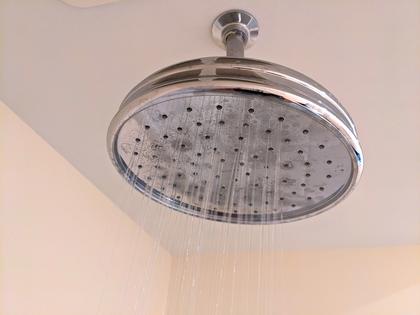Ask the Builder: Deluxe remodeled shower with abysmal water flow
Each week, I extract quite a few homeowners like you from wretched remodeling or home-building quagmires. I do it with a phone or video call. In almost all cases, the root causes of the dilemmas are poor plans, sketchy or nonexistent specifications, and misplaced trust.
A week ago, a middle-aged woman was lamenting her luxury master shower remodel. The walls were covered in breathtaking marble. Step into this private oasis, and you will see a large rain shower head, three body sprays and a hand shower wand.
What the woman didn’t have was water flow. A somewhat decent flow would come out of the shower head on its own, but if you turned on any of the other accessories while water was flowing from the shower head, the water flow and pressure would drop. It was pathetic and unacceptable. Sadly, she didn’t discover this until after the entire shower was complete. When she entered the shower to enjoy it for the first time, she exited the shower wet and disgruntled.
As you might imagine, she complained to the remodeling contractor. The project superintendent and the plumber immediately said the water pressure in the house was too low. They were sure a booster pump would solve the problem. Just like doctors order scans, X-rays and other tests before performing surgery, the plumber should have performed a pressure test before he cut open the walls. It was his professional obligation to determine if the existing conditions would support the new fixtures that have an insatiable appetite for water.
I’ve been a master plumber for over four decades, and I knew immediately what was causing the low-pressure and volume issues. The woman was smart enough to take photos of the job’s progress. Several photos showed the plumber installed 1/2-inch PEX water lines with flow-restricting hard 90-degree fittings. This PEX fed water to all the accessories.
Before the work began, the water pressure and flow in the original tub and shower was fine. An independent inspector verified the incoming water pressure was 70 pounds per square inch (PSI). The woman shared that prior to the remodeling, she could take a wonderful shower with plenty of water. Her tub spigot gushed water if she wanted to soak in a bath. The tub and shower were piped with 1/2-inch copper tubing.
If you don’t want to be frustrated with your new fancy shower, please pay attention. All of the pain the woman has endured could have been avoided with a pencil, paper and ten minutes of time. The plumber failed to do the simple calculations that would have shown him the correct pipe size to feed the bathroom and the size of the pipes that extended to each accessory.
You can view the Uniform Plumbing Code online. Within this large document, you’ll discover a table showing load values for all the common fixtures in your home. The load values are stated in water supply fixture units (WSFU). It just so happens that one WSFU equals one gallon of water a minute of flow.
A normal residential bathroom like the woman had before the remodeler showed up has 2.7 WSFU of cold and 1.5 WSFU of hot water. Since you don’t use all the fixtures at the same time while in the bathroom, the blended total is 3.6 WSFU. A normal shower head has 1.4 WSFU. A seasoned plumber would almost always run a 3/4-inch diameter cold and hot water line to this bathroom. He’d branch off this larger pipe with a 1/2-inch pipe to each fixture. It’s quite possible that the woman’s shower, once the calculations were run, might require 1-inch hot and cold water lines to be extended from the basement up to the second-floor bathroom.
All five of the new fixtures in the shower consume 11 gallons of water per minute if you turn them all on at the same time. That’s just about 10 times the water flow the original shower head consumed! The gallon-per-minute (GPM) flow of each accessory can be found in seconds in the product brochure or online specification sheet.
It doesn’t end there. A diligent plumber will also calculate the pressure loss from the height of the bathroom above the water meter, the pressure loss through the water meter, a backflow preventer, and any other pressure regulators.
Here’s another factor the woman’s plumber probably didn’t take into consideration. He replaced the copper tubing with plastic PEX. One-half-inch PEX tubing has a slightly smaller inner diameter than 1/2-inch copper. The plumber made the situation worse by using the smaller diameter PEX.
Here’s what you should do when you get ready to install luxury water fixtures in your home. Include in your contract with the builder or remodeling contractor that the plumber must produce all the pipe-sizing calculations. You can easily find webpages that allow you to determine pipe size once you know the total WSFU load in your job.
All that said, don’t hope it’s all going to work. Put it in your contract that you get to test the new shower before the marble or tile is installed. It would take just a few hours for the plumber or remodeling contractor to cover the walls with 6-mil plastic that’s taped to the shower drain. Give the new shower a test drive before the expensive tile and marble are installed. You should only hope for things you can’t control, like the weather and lottery numbers.
Subscribe to Tim’s FREE newsletter at AsktheBuilder.com. Tim offers phone coaching calls if you get stuck during a DIY job. Go here: go.askthebuilder.com/coaching
©2024 Tim Carter. Distributed by Tribune Content Agency, LLC.







